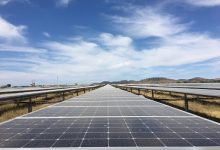Fortescue Metals Group is gearing up to test whether it can run its Pilbara-based Christmas Creek iron ore mine on solar, alone, during the day and Alinta Energy, the miner’s partner in the project, says it is confident the ground-breaking goal can be achieved.
The trial will draw power from a solar and battery project Alinta has been building in the Pilbara region of north-west Western Australia, in a bid to slash energy costs for the big mining operations in the area and underpin in new investments and mine expansions.
The 60MW Chichester solar farm, first revealed by RenewEconomy in August 2018, is located near Fortescue’s big Christmas Creek iron ore mine (see map below) but aims to service mines all along a new transmission line also being built by the energy utility.
As RenewEconomy has reported, the solar farm is part of a major project that will extend the Alinta transmission line that runs from the Newman gas generator to Roy Hill mine by another 65km to Christmas Creek and Cloudbreak.
The Newman generator had already made a name for itself with the inclusion of a 30MW/11MWh battery that enabled the gas plant to shut down one of its unit and to maintain power on its own when the gas units have tripped, significantly lifting the reliability of power supply to its big mining customers, and significantly lowering costs.
In an online presentation and panel discussion at this week’s Energy & Mines Summit, Fortescue’s manager of energy and power, Bethwyn Cowcher, said the bid to use Alinta’s network to achieve up to 100% instantaneous daytime energy from solar was a key milestone in the miner’s bid to achieve net-zero emissions by 2040.
“It is a challenging project …But we think that it’s achievable. And we think that the way we operate our systems … will facilitate the delivery of that system,” Cowcher said.
“Battery storage, interconnection of the grid, they’re really the key things we’re focusing on at the moment. The big piece of renewable penetration we’re getting is the network connected piece that Alinta are doing at the moment.”
The trial will be critical as Fortescue plans to expand its solar and battery operations at its other iron ore mines in the Pilbara, building a new transmission line that will be serviced by 150MW of solar, another big battery, and a new array of gas generators.
On Alinta’s side of the project, the utility’s general manager of asset strategy, Gary Bryant, told the webinar that the Chichester Hub project addressed “the challenge of our time” in delivering high penetration renewables to major, grid-connected mining projects.
“[This] is a network that is as complicated as the NEM but with fewer customers,” Bryant said.
“But the customers are far more demanding because, right now, the iron ore price is sitting at $US115 a tonne. And Fortescue is exporting .… half a million tonnes per day – that’s $40 million per day of (potential) revenue loss, or $2 million per hour when they don’t have power.
“So it’s really hard to understate how important it is that you have a good reliable supply for miners.”
But Bryant says Fortescue, which is controlled by billionaire Andrew “Twiggy” Forrest, has the right “risk appetite” to go with trying to get a substantial amount of renewables into their portfolio.
“One of the things that Fortescue has done and it’s really market-leading, and I’ve decided to call it out; they’re offering their Christmas Creek mine to us for a day to trial solar and battery by itself, and that’s one of the obligations that we have under the ARENA funding that we received for that project is to give that a crack,” he told the summit.
“And we know right now … it will be a challenge and we’ve got calculations to do, but we think the battery, probably, it’ll do enough for us. So watch this space.
Bryant said Alinta was certain the solar and battery system would meet the inertia ratio of what was needed for an operating mine of up to 35MW, and reasonably confident the short circuit ratio would allow the team to get the Christmas Creek mine to operate at 100%.
“The things we don’t really understand at this point in time is how the solar field operating at near 100% is going to interact with the Christmas Creek mine, and we will be doing an actual test …as part of that project and we will be letting everybody know how we go.
“Hopefully that will assist everybody to identify other things that we haven’t thought about on the path to getting our mining industries up to very high levels of penetration,” Bryant said.
Cowcher added that Fortescue expected the learnings from the Chichester Hub project to be quite important for the broader industry and miners.
“They do a couple of things. One, to show the technology works and therefore provide a bit more comfort for miners to take a bit more risk, given the productivity impact. And two, it just challenges the status quo and allows companies such as Alinta and other generators to have a look at ways to do business a little bit differently to achieve those targets.”
Fortescue, which has committed to using solar and battery storage to supply up to nearly one-third of the power needs of its Pilbara iron ore mining operations, announced a zero “operational” emissions target by 2040 in June this year and pledged to support the Paris “well below” 2°C climate target.
Forrest has also emerged as a potential leader in the decarbonisation of Australia’s economy by joining software billionaire Mike Cannon-Brookes in backing the first stage of the ambitious Sun Cable plan to build the world’s biggest solar farm (10GW), the biggest battery (30GWh) and the longest sub sea cable (3,700kms) to deliver clean energy to Singapore and other south-east Asia customers.











